| Development updates | - Magda: There are not that many changes to the UI. You can now choose a file to upload and get a response to choose the file but then you will receive an error message that the file failed to upload. The reason for this is that there is a lot of backend work that is happening, and we can see this on the development team scram board. There are a lot of stories that have been completed but just a handful of the UI stores have been implemented because of back-end dependencies.
- Magda: If you want to see what is done on the backend, you can click on the user stories and look at the comments where developers update step by step what the requests and responses are on the backend. This is a good way for me to validate the story to make sure it is working as expected.
- Magda: But for those who would like to venture into accessing the functionality using the backend directly using the API calls, this will be helpful as well.
Magda: In addition, when the development progresses and we see changes in behavior we can go back to the original story to see how it was implemented. Magda: So, not much to see on the front-end in the UI. The progress was mostly on the backend. Hopefully, by the end of the week which is the end of the sprint, we will be able to see more functionality here in the UI. Magda: The Rancher Environment: Magda: I requested a separate environment for us to do user acceptance testing. It will not be refreshed nightly, rather only on request, and we'll have a little bit more data than is currently in the snapshot environment. Magda: The URL is https://concorde.ci.folio.org/settings (diku_admin/admin) for now. It may change. Magda: There are still issues with this environment. It is missing some data. Only has a few modules. Obviously, we will need to have a Bulk Edit which is not currently there. But when you click on the users, there are 35,000 records right now. Magda: Do you feel this is enough data? Erin: Is the record count at the top actually correct because that's not always? - Magda: It is still running Postgres, but I spoke with the developer and the number of user records is close to 35K and not less.
- Erin: Yes, I think so (in response to Magda's question about the number of records being enough).
- Magda: We can start with this and see how it goes. My concern was about performance. The development will be completed by next Friday and we can talk about this at our next meeting.
|
| Slide 17: - Provide a more transparent way of understanding what FOLIO did when batch processing
- Better understanding of what a failure means -- did it revert the record, delete the record, invalidate the record?
- Itemize failures so it’s easy to identify affected records, e.g. “record #XXXXXX failed,” not “7 of 10,000 changed failed”
- Pay particular attention to global failure where feedback is especially spare
- Give some indication, if possible, of how failure can be avoided
- Provide some indication on how to re-try or follow-up from a failure
Slide 19 - Optimize .csv files for understandability
- Make it very clear which fields can or should be edited and which should be avoided (in app or local edits?)
- Provide some degree of instruction on how to make changes to commonly edited fields like status and location (in app?)
- Give users the power to rollback changes upon upload if files are corrupted or mistakes were made (pre-update records stored in S3)
- Anticipate potentials error and provide warnings, e.g. “Is this correct?,” “Are you sure?”
Mockup- file upload | Mockup - are you sure | Mockup - delete modal | Mockup - delete errors | Mockup 5 - file upload .png?version=1&modificationDate=1639859876000&cacheVersion=1&api=v2&width=640&height=400)
- Magda: The user has uploaded the file with the IDs but there were errors while the reports were being matched.
- Magda: You submitted 302 records. You get only 300 because we did not find a match for one. And the other one was was duplicate.
- Magda: No changes have actually happened yet. This is a preview of the records.
- Erin: Is the preview of the records showing me what is in the file or in the system or both?
- Magda: Your file contains only the list of your UUIDs, nothing else. This data comes from the user table.
- Magda: The preview pulls from the top of the list. It will list the top 10 records in the implementation.
- Magda: This is showing the user why only 300, not 302 were matched and reason.
Mockup 6 - actions dropdown 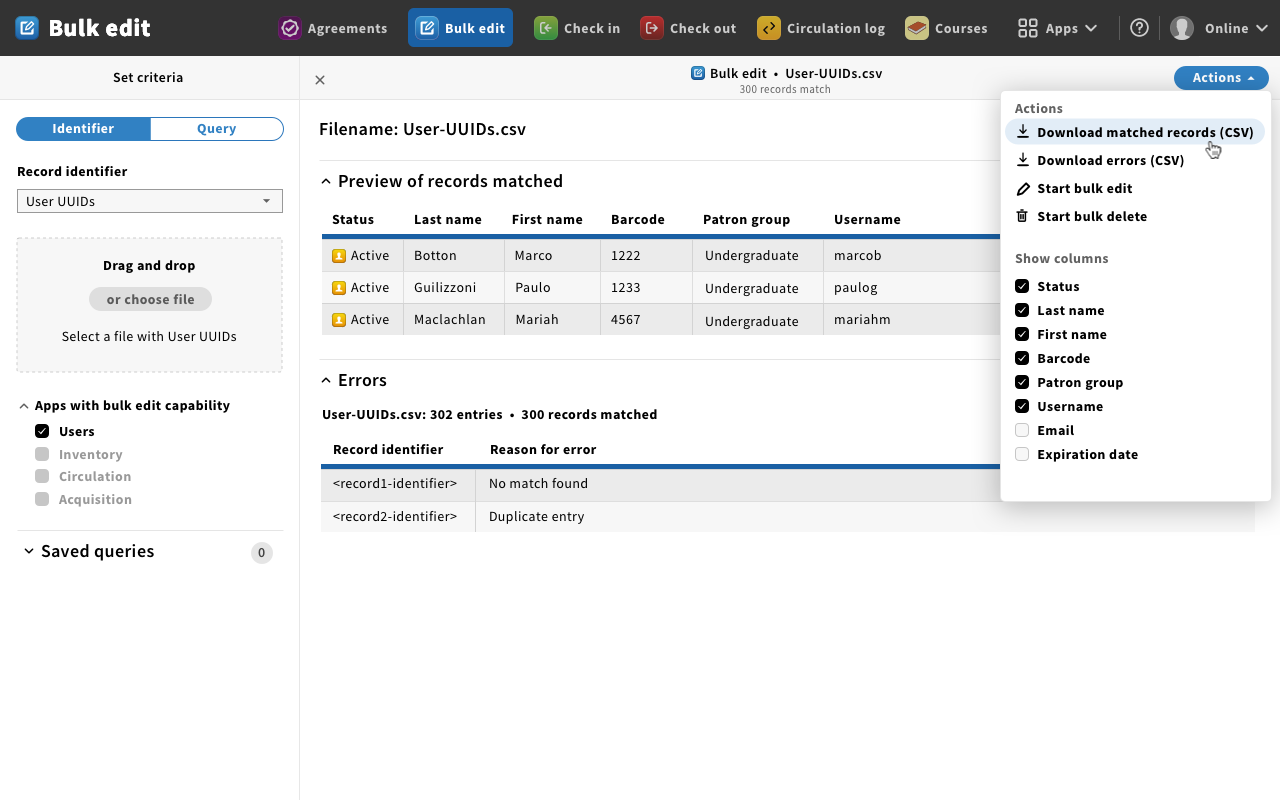
- Bob: Can you export those?
- Magda: You can download the matched records and download the errors from here in CSV format.
Mockup 7 - download matched records 
- Magda: This is the example of saving the file with the records that we marched with the standard naming convention displayed at the bottom.
Mockup 8 - actions dropdown start bulk edit 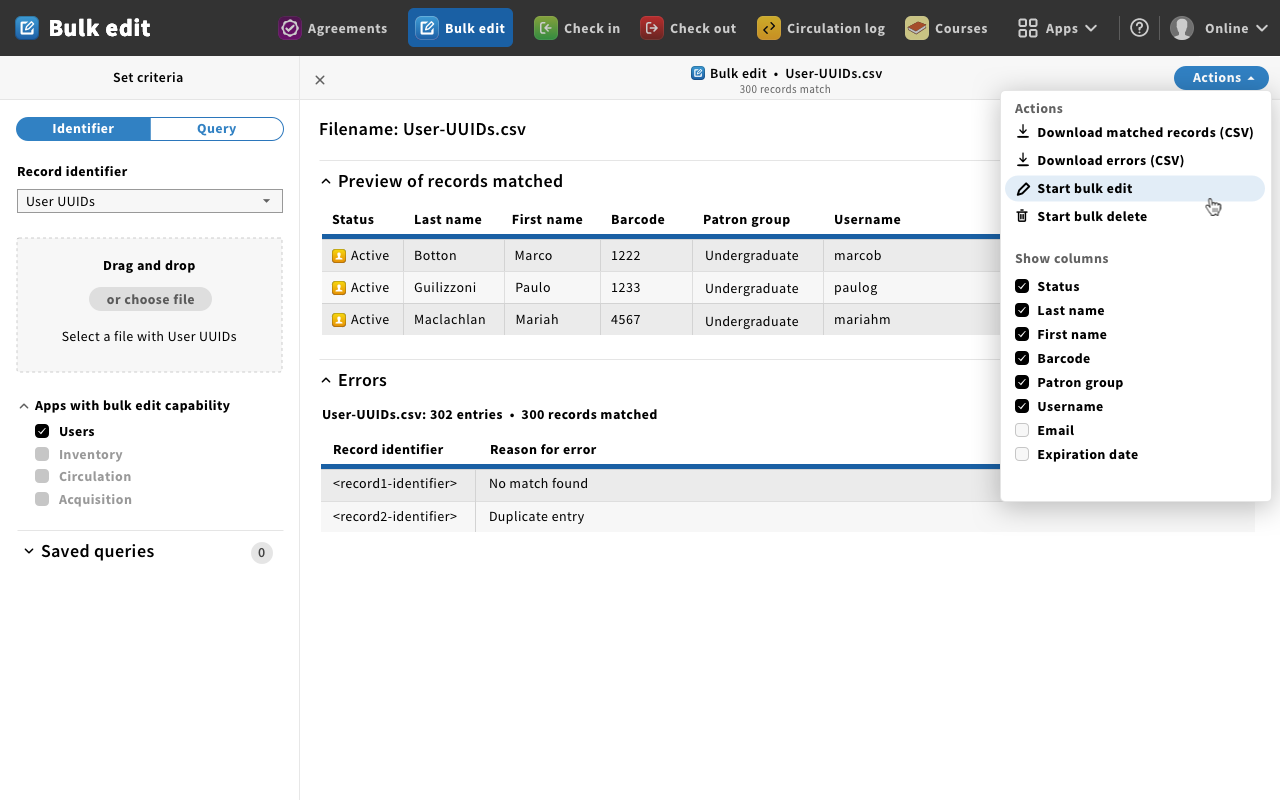
- Magda: This is an example of starting the bulk edit process.
Mockup 9 - bulk edit modal 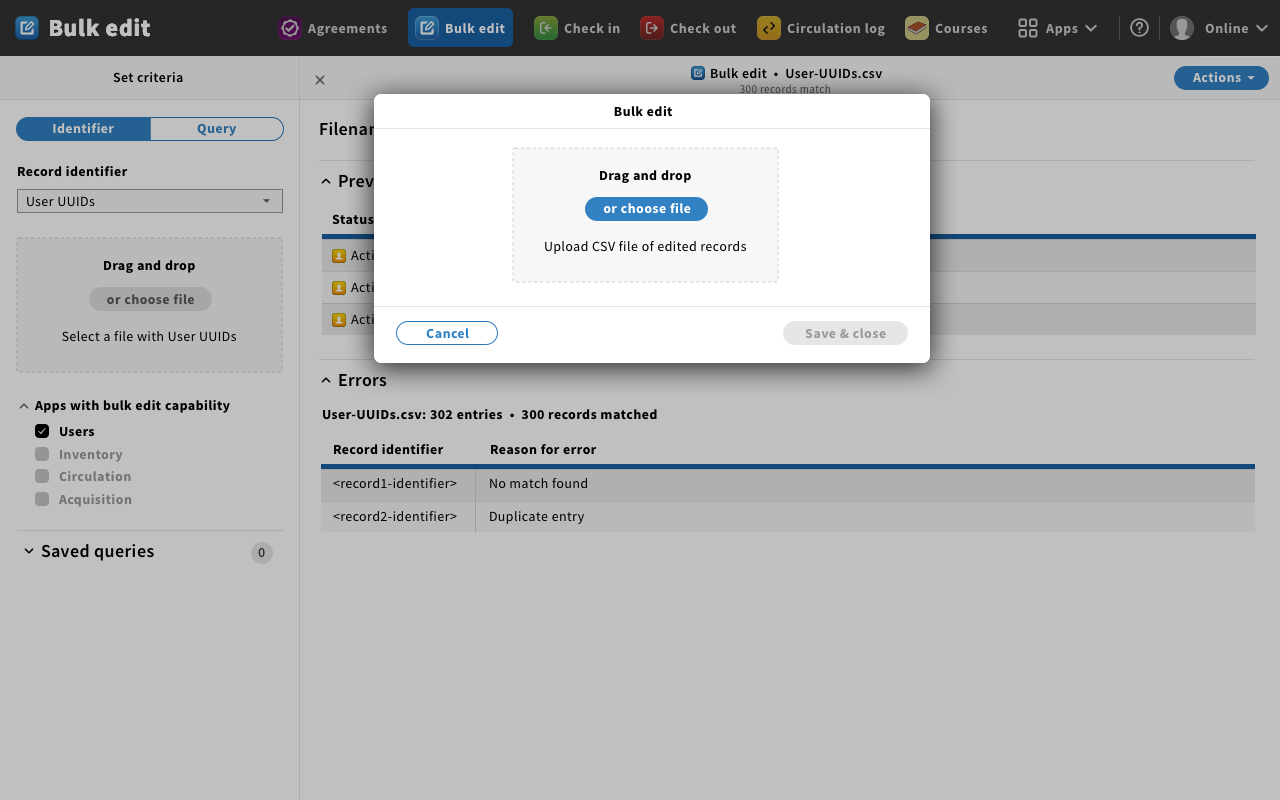
- Magda: Example of uploading the file from your local machine with changes you made locally.
Mockup 10 - drag and drop

- Magda: This shows the process of dragging and dropping the file to upload. You can also browse to the file via your local computer's file system.
Mockup 11 - bulk edit confirm

- Magda: You uploaded the file with your changes. This message is letting the user know that once you click save & close, 300 records will be changed.
- Don: Are the records you are working on locally locked in the system while you are doing this?
- Magda: No (I did not hear any elaboration on this point that Dan brought up)
Mockup 12 - progress bar

- Magda: The uploaded file is being processed on the backend.
- Magda: The progress bar is provided to monitor the progress.
Mockup 13 - success 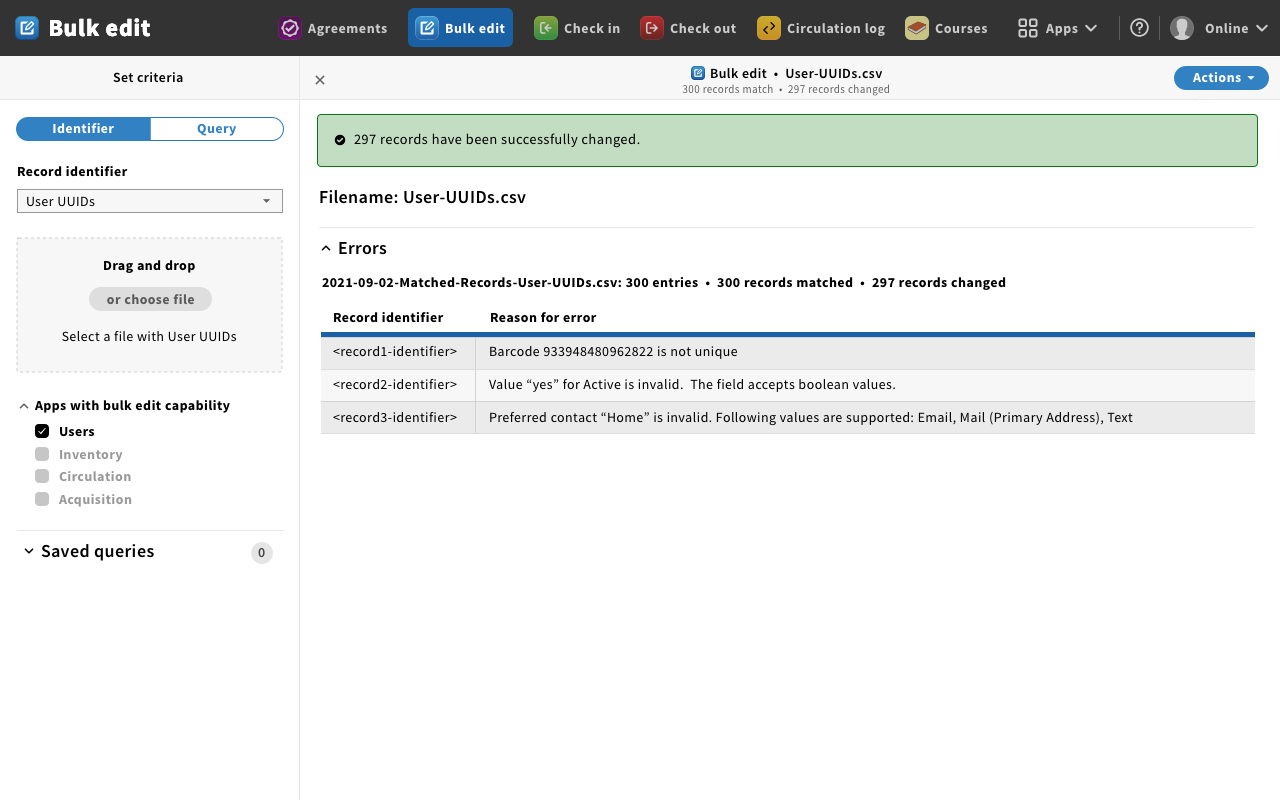
- Magda: Process completes with a message to the user that 297 records were changed the way you specified.
Mockup 13 - success2 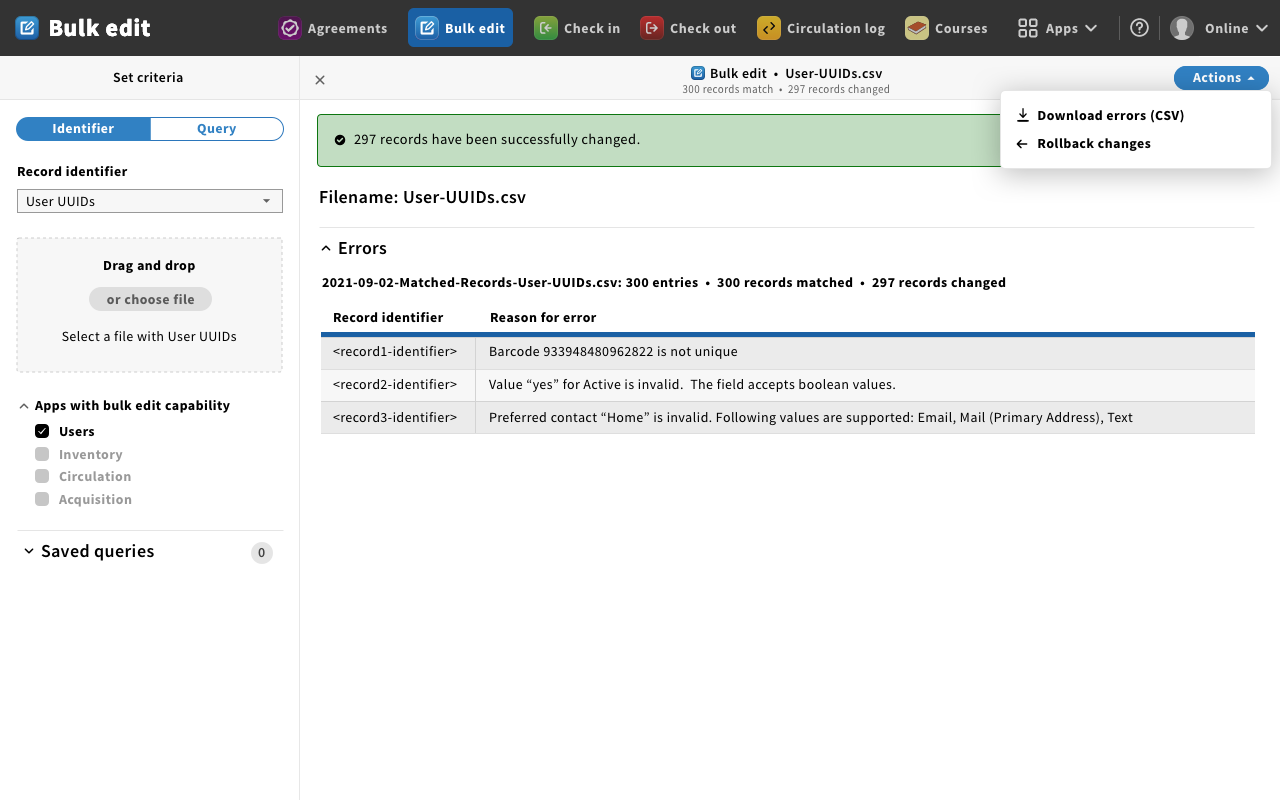
Magda: However, there were some errors. One of the barcodes that you provided was not unique. So the record was not processed, and the record in the FOLIO was unchanged from what it was before you began the process. You provided invalid data. You wanted to change some of the users to be active, but you provided populated it with the word "Yes" when the value should be true or false. - Preferred contact data was also invalid. You provided the word "Home" when valid values can only be "email" "mail" or "text."
- Thomas: With the data upload, do you have to return the full CSV file, or can you just return the fields you want to be updated? By only sending the data you want to be updated lowers the chance that you would change another field that may have been changed in the system by another user in the interim when you were working on the file locally.
- Magda: This is a very good point and I will bring it up with the developers.
- Erin: If you are not sending back all the fields you have to be very careful that your mappings are absolutely correct. Example: sending 500 email addresses mapped to the first name field.
- Christie (Comment via chat): There's also the chance of data corruption introduced by the tool that you are editing the data with outside of FOLIO. So I think the safest option is to send just the data that has changed.
- Bob: One system that I use has a mapping confirmation process built into the interface. You can see it here: https://help.memberclicks.com/hc/en-us/articles/230535007-Profile-Import.
- Sara: It's not even that we have to introduce corruption. It can also be even within a very short amount of time, not days of having the file out and then putting it back. Somebody finds a typo in a person's name and fixes it. And then if I overlay the record completely, then I just put the error back. I think that's also something we have to keep in mind that going forward is that we can have the option to either put or patch and we should be able to distinguish between the two. Sometimes you want to totally overlay a record. Then also very often you just want to correct a very specific part. And I think we do need to have that capability of being able to do that safely. To add a line without saying that we're going to overlay it all again. I can do that with my current system.
- Magda: When you say add a line do you mean to add a new record?
- Sara: No I mean adding for example emails to records where that data element is missing in some of the records.
- Magda: So when you get the file from the system, you will have the email column. In your example, the email column will be empty. So then you would populate that.
- Sara: Are you were saying that all columns are always present, whether they have value, values associated with them?
- Magda: Yes.
- Magda: I would like to make a comment about the patch and put in post methods. To be honest, I'm not sure in FOLIO if we support patch. Maybe we do, but I know most APIs that I worked with support the post method the new records and put for modifications.
Magda: I see the problem with what Sarah mentioned, someone changed or corrected the name of the user. And we are overwriting the data. And to be honest, at this point, I don't have a quick and easy solution for that. This may happen. Definitely. - Don/Mark?: You can use get then put to achieve essentially the same things as a patch.
- Magda: Also something to consider. I will discuss this with the developers.
- Christie: I do think that if you're just changing one property like location, the easiest thing to do is to just replace that JSON object in the record, and that's the safest thing to do. I'm just wondering whether or not this model supports the ability to null things. And I think that you would have to do a replacement of the whole record if you wanted to remove a value because of how nulls are represented in JSON.
- Christie: I wanted to point out that we have this issue in data import, and I don't know what the commands are for working with the data via the API, but there's a difference between an overlay and a merge, right? You want to replace the whole record, or you just want to add a new property to the record, or a new value for that property, or you want to replace a previous property with a new property, or you want to remove a value. And being able to just impact that one file is really powerful, especially because of the business logic that is sometimes triggered by these operations.
You could be having an impact on the data that is not explicitly changing a value. So I do think that there is a need to be able to do that. Again, I'm using the terms from data import that we have settled on, overlay, which has replaced the entire record, and merge, which is just replacing or somehow otherwise modifying some of the data that is targeted.
- Magda: I understand your point, Christie. I think what we do, and I think this comes from the software development approach, is editing. Editing the record includes removing the data, adding the data, or updating, changing the value of the data, but this is happening on the record level and the properties. So you can populate a property that did not exist, remove the value of the property that was populated, or change the value. And you said a couple of things that are very important. One of them it's merging the records. And from what you're describing, you understand the merging as the changing one property of the record, right?
And then let's say the last name has changed for the user and everything else stays as it is. So you would call this merging of the record, right? You are updating only one property of the record. I understand that as an update, you are updating one field. If you get the copy of the record on Monday, and on Tuesday someone realized that there is a typo in the first name, and then you are uploading the file again on Wednesday. And your file has a first name and last name. The first name is not changed. And their last name was modified to the new value you wanted to change. And you send the request to the user API. What will happen? You will overwrite the Tuesday changes to the first name, and you will add the last name update the way you want it. Does it make sense?
- Christie: It does make sense. I just think that we would want to be very careful. I realized that we're talking specifically about users here, but I'm extrapolating it to the type of data that I work with, which is pretty much everything but users. So, maybe I'm thinking more of the UIs we use. I think that this model isn't traditionally how we have thought about editing records in batch. So, I think it's going to be very important to have a lot of documentation about what you are doing because you every system that I've worked with if I need to change the location, all I have to do is submit the record ID and the location. And I can see somebody accidentally wiping out everything but the location and their holdings records.
- Magda: Christie, this is an additional argument for having an in-app bulk edit that would allow you to change just one field. You probably, in the long run, will not use the CSV approach If you want to change one field. You will probably go with the in-app approach. And what you said that you are working with other records, but users, what we are trying to do in the bulk, uh, pilot project is set the, um, expected behavior and then build on this on other, um, record types. So definitely, uh, the, the feedback you are providing here, um, is helpful.
|
.png?version=1&modificationDate=1639859876000&cacheVersion=1&api=v2&width=640&height=400)








